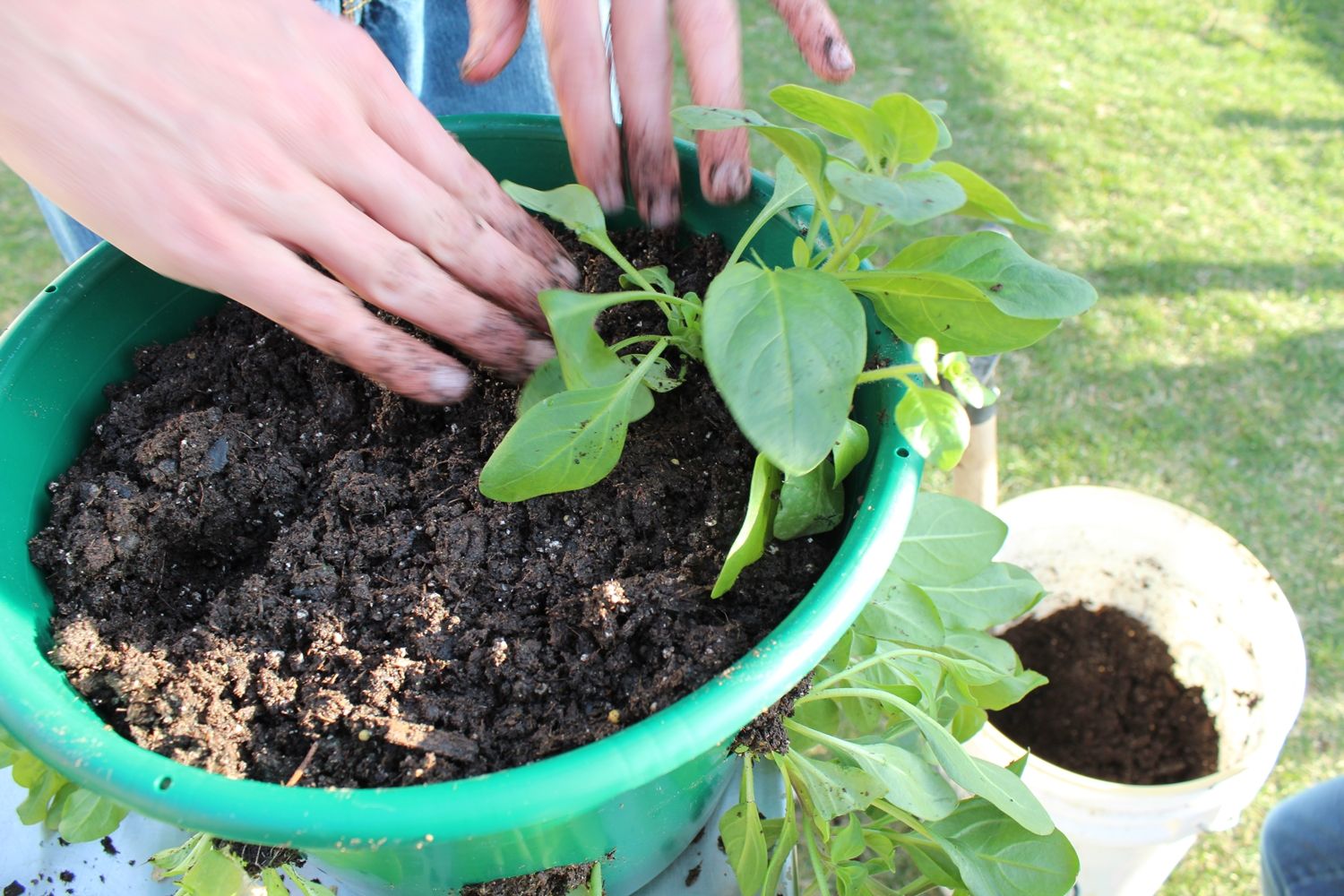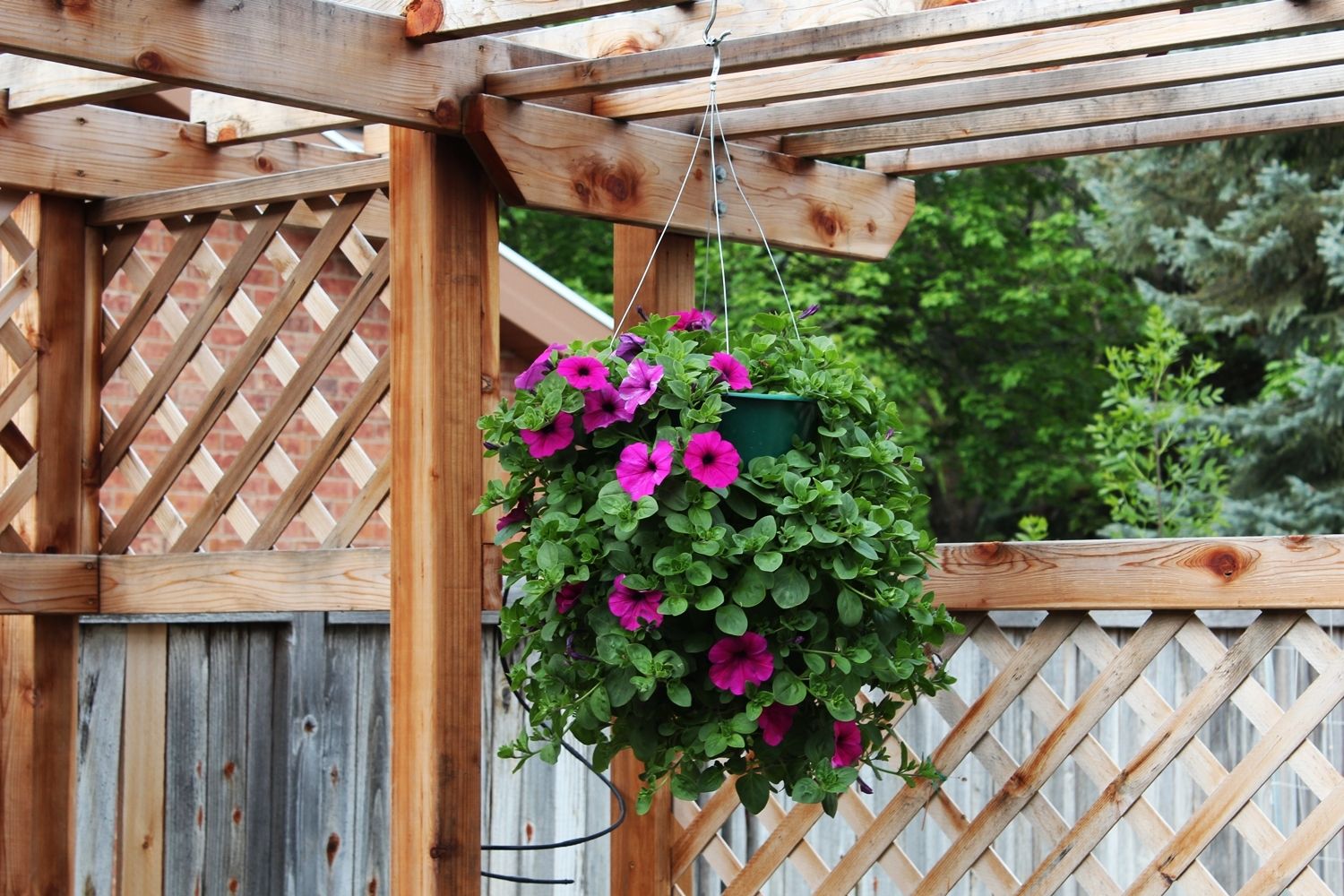Nothing says “summertime” quite like a gorgeous hanging basket. While purchasing a large, bloom-ful basket from a nursery or garden center is certainly the easy way to bring summer color into your yard, the purchase can be quite expensive. Did you know that there’s an easy way to achieve the gorgeous look of a professional hanging flower basket without the hefty price tag? There is! It just takes a few weeks of planning ahead. Read on to learn how to grow a gorgeous hanging planter with your own starts, and your own hanging baskets will bring you joy and beauty and soon become the talk of the neighborhood.


DIY Level: Beginner
Materials Needed:
- Flower starts (example shows blue cascade petunias and purple Wave petunias)
- Hanging basket with holes on the sides
- Potting mix (NOT soil)

Have your flower starts ready to go. This example shows a combination of petunias – cascade blue (the darker purple blooms; the flower world tends to label purple as “blue”) and wave purple (the fuchsia blooms). Wave petunias are a brand of petunias highly recommended for hanging flower baskets because they maintain a lovely, full, non-gangly shape over the course of their life and don’t require dead-heading. They are more expensive than other petunias, however.

Have your plastic hanging basket ready to go as well. We recommend this kind, with holes on the sides, in whatever gallon size fits your space. They range from 1- to 6-gallon sizes, with varying numbers of planting slots.

Lastly, have your potting mix ready to go. Great soil medium is imperative in the success of a hanging basket, and you’ll want to choose potting mix rather than potting soil for a few reasons: (1) potting soil is dirt, whereas potting mix is a soil-less growing media designed for containers, (2) a high quality potting mix has larger particles than soil particles, which is key in containers because it makes the growing medium capable of holding both more air and water than actual soil. This allows for the circulation of fresh air and water without drowning your container plants.

Pour some potting mix into a bucket, wet it down, and stir it. It should be wet enough to be sticky, but not quite mud.

Fill the bottom of your hanging basket up to the bottom of your first row of side slots.

Smooth the soil then pat it down gently. (Note: Although I use the word “soil” for simplicity in this tutorial, I am actually referring to potting mix.)

Working on just the bottom row of side slots, add in your flower starts. It’s easiest to work with the flower, feeding it into the pot from the outside in (if the soil base of the start is small enough; otherwise, you’ll need to carefully feed the flower plant through the slot from the inside).

Work the flower/soil in until the base of the flower is even with the side of the hanging basket. Carefully spread the roots.

Feed in the flower start on the slot directly across from the one you just did. If you are creating a combination basket, pay attention to which flower you’re putting where. This example shows two purple wave petunias planted directly across from each other.

Two blue cascade petunias were added into the remaining two slots on the bottom row. These two flowers are also directly across from each other. This will create a lovely combination effect in the blooming basket, so the colors won’t be split directly down the middle.

Gently add more potting mix into the hanging basket, on top of the roots, up to the bottom of the second row of side slots.

Your pot will look something like this, with first-row roots fully covered and soil gently and evenly patted down.

Repeat the planting method of your flower starts on this second row. Again, if you’re creating a combination basket, alternate the type/color of flowers as you plant them in the slots.

You’ll notice a gap between the base of the flower start and the top of the planting slot. That’s okay, because the moistened soil layers will cover those up and fill them in without too much trouble.

When the second layer is planted and complete, carefully add more potting mix to an inch or two below the top rim of your hanging basket.

Gently pat down the soil. Remember that when you water this basket, the potting mix will compress a bit, so you want to have enough in your basket from the beginning that this won’t be a problem and expose your flower start roots and/or starve them of their needed nutrients.

Make holes big enough for planting flower starts in this top layer.

Plant the starts, taking care to keep roots covered. Add a little more potting mix around each flower start as needed.

In this example’s 2-gallon pot, we planted four flower starts in the top, two each of blue cascades and purple waves, both types directly across from each other.

Feed the wire hangers into the pre-punched holes on your hanging basket.

Taking care to keep the wire lengths even, bend them back against themselves and secure by twisting the wire ends around the wires themselves several times.

Viola. There’s your hanging basket. Be sure to add container-focused fertilizer to your plants two to three times a week, following the dilution ratios on your fertilizer. Also, these flowers benefit from having the fertilizer applied to the leaves occasionally, so one of the weekly fertilizations include a sprinkling over all the foliage. On other days in between fertilization, simply water the basket.

This photo shows the growth in the flower starts about two weeks after potting.

You can begin to see, even after just two weeks, the difference in fullness and blooming of a side-slotted hanging basket versus a traditional hanging flower pot.

This photo shows the growth in flower starts about three or four weeks after potting. Notice its fullness and filling in.

Although the blooms aren’t completely full, that’s due more in part to the immaturity of the flower starts to begin with than anything else. Based on the number of small buds forming, we expect major blooming in the next two weeks.

This photo shows another hanging basket, planted at the same time as the tutorial, with just purple wave petunias. This photo was taken two weeks after potting.

You can see the beautiful shape and silhouette of the wave brand of petunia for hanging baskets in this photo, taken just three or four weeks after potting.

The green pot has almost disappeared behind the beautiful flowering.flowering. (Note: Learn how to create a grape arbor, seen in the background, in this step-by-step tutorial).

We hope you’ve found this tutorial helpful in your creating beautiful hanging baskets for your own yard and garden. Good luck, and happy planting!
You’re reading How to Plant a Professional-Looking Hanging Flower Basket , originally posted on Homedit. If you enjoyed this post, be sure to follow Homedit on Twitter, Facebook and Pinterest.
The post How to Plant a Professional-Looking Hanging Flower Basket appeared first on Home Decorating Trends – Homedit.
via. Home Decorating Trends